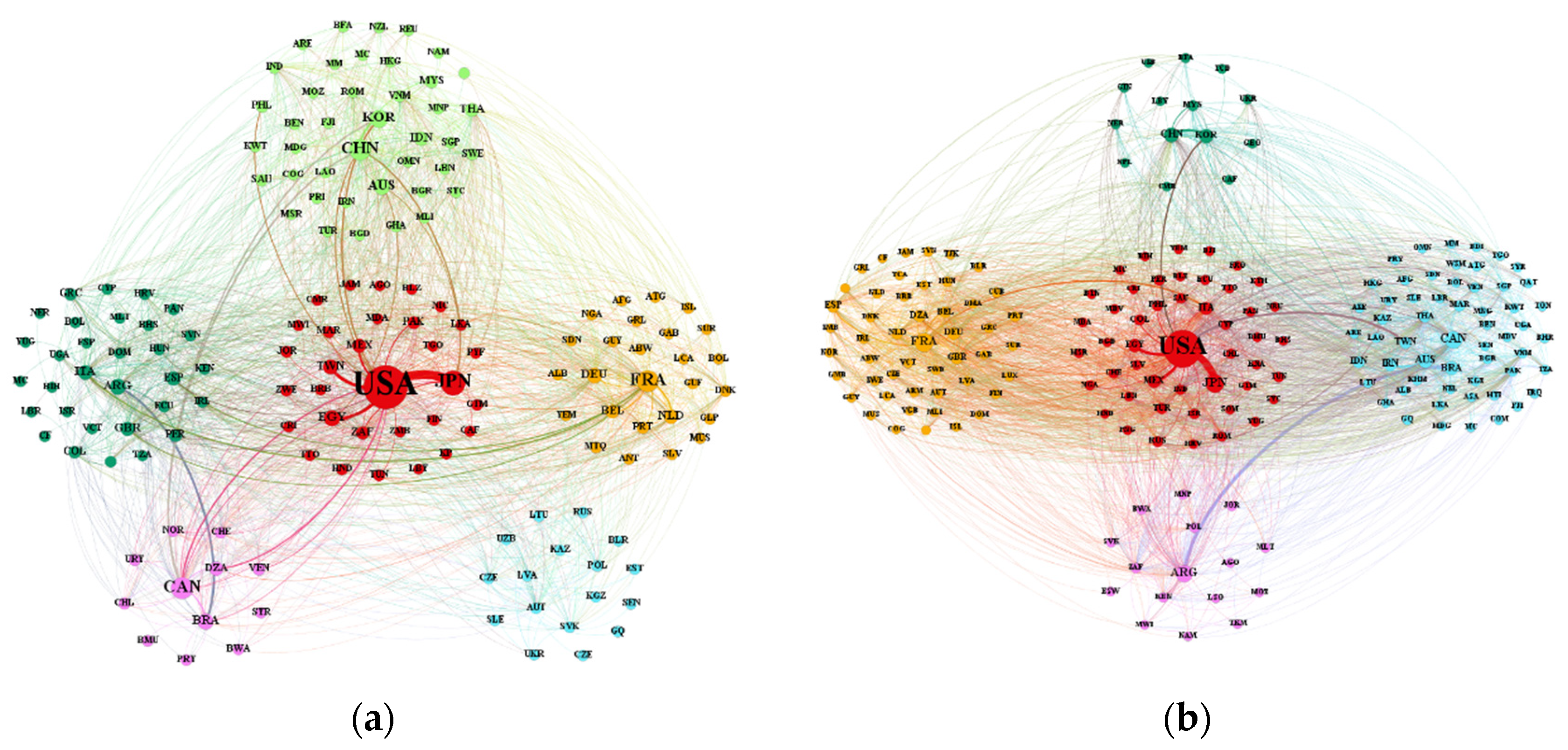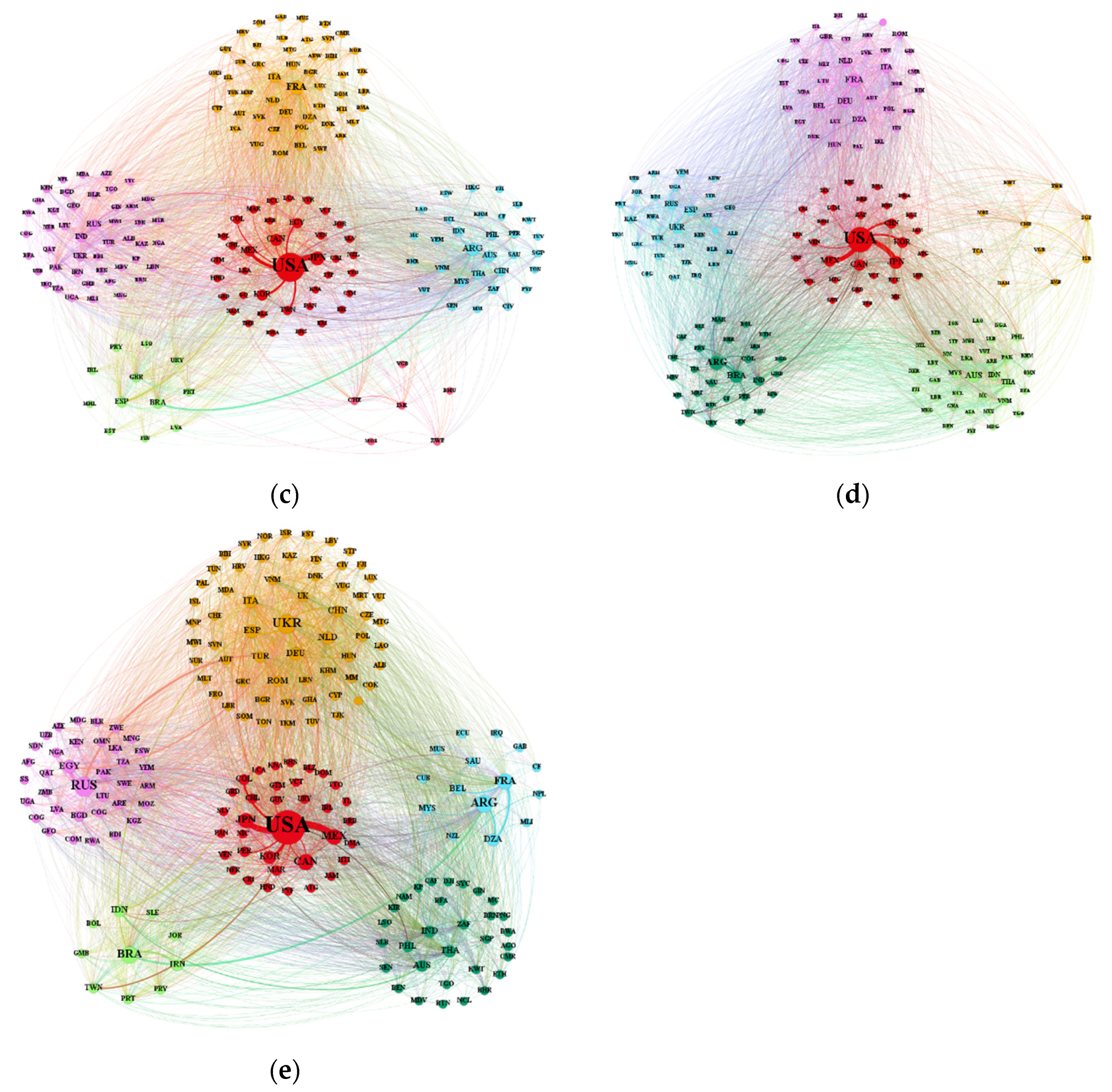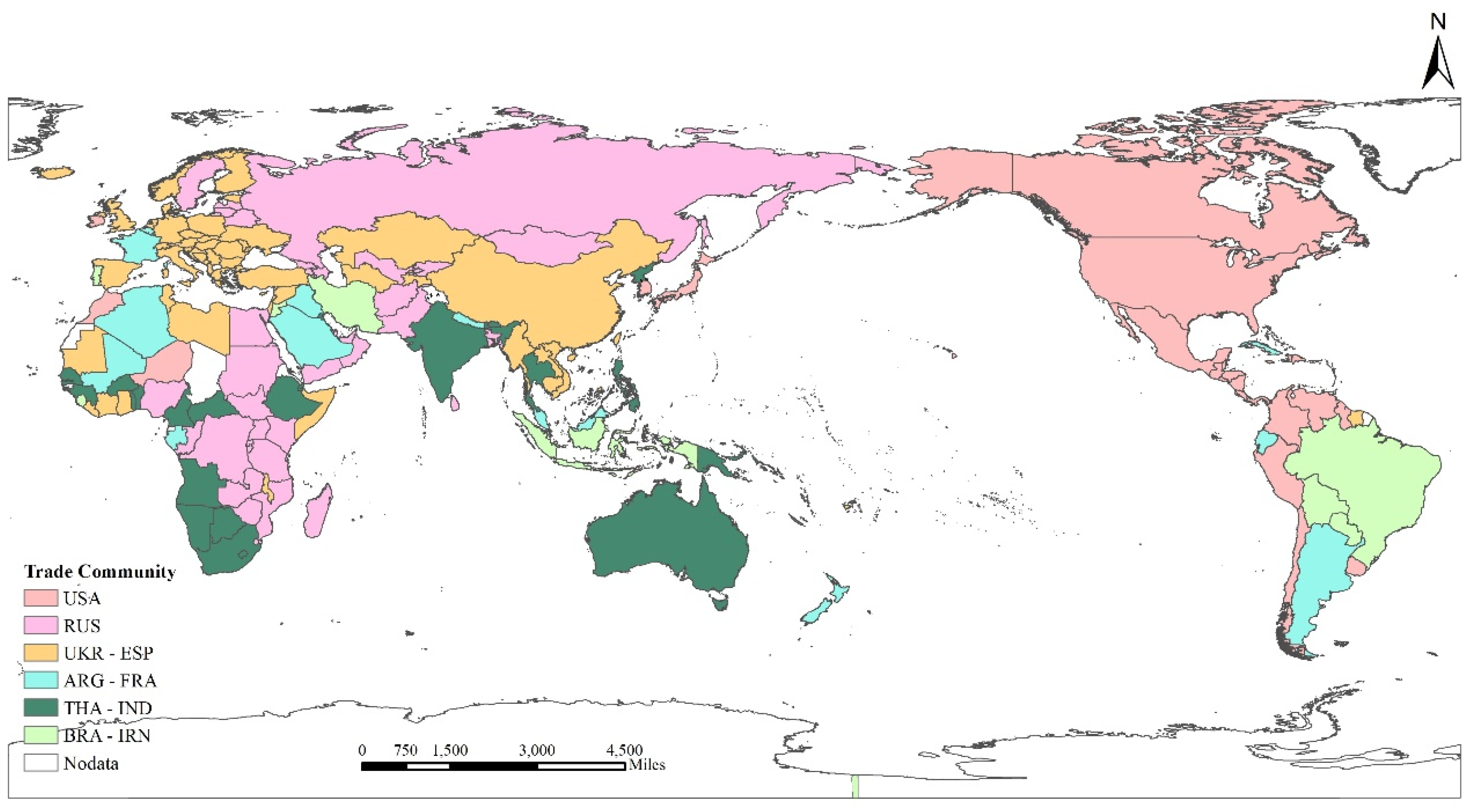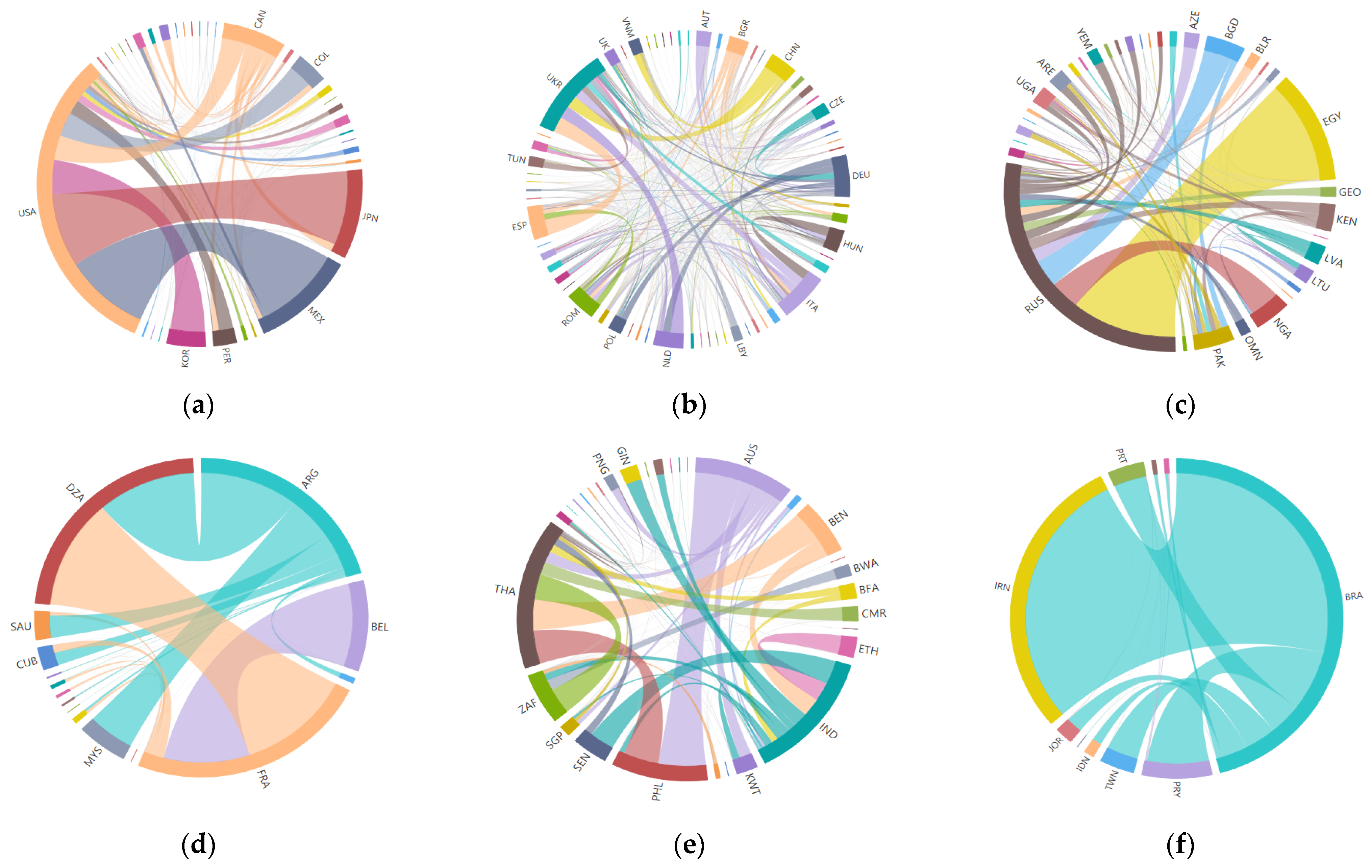Evolution of Global Food Trade Patterns and Its Implications for Food Security Based on Complex Network Analysis
Abstract
:1. Introduction
2. Materials and Methods
2.1. Data Sources and Processing
2.2. Network Modeling
2.3. Network Measures
2.4. Community Discovery
3. Results
3.1. Network Characteristics and Analysis
3.1.1. Network Scale
3.1.2. Network Connectivity
3.2. Community Structure and Analysis
3.2.1. Evolution of Community Structure
3.2.2. Community Pattern in 2018
3.3. Positions of Core Countries
4. Discussion
5. Conclusions
Author Contributions
Funding
Informed Consent Statement
Data Availability Statement
Acknowledgments
Conflicts of Interest
References
- Rosegrant, M.W.; Cline, S.A. Global food security: Challenges and policies. Science 2003, 302, 1917–1919. [Google Scholar] [CrossRef] [PubMed] [Green Version]
- Godfray, H.C.J.; Pretty, J.; Thomas, S.M.; Warham, E.J.; Beddington, J.R. Linking Policy on Climate and Food. Science 2011, 331, 1013–1014. [Google Scholar] [CrossRef] [PubMed]
- Foley, J.A.; Ramankutty, N.; Brauman, K.A.; Cassidy, E.S.; Gerber, J.S.; Johnston, M.; Mueller, N.D.; O’Connell, C.; Ray, D.K.; West, P.C.; et al. Solutions for a cultivated planet. Nature 2011, 478, 337–342. [Google Scholar] [CrossRef] [PubMed] [Green Version]
- Davis, K.F.; D’Odorico, P.; Rulli, M.C. Moderating diets to feed the future. Earths Future 2014, 2, 559–565. [Google Scholar] [CrossRef]
- Beltran-Peña, A.; Rosa, L.; D’Odorico, P. Global food self-sufficiency in the 21st century under sustainable intensification of agriculture. Environ. Res. Lett. 2020, 15, 95004. [Google Scholar] [CrossRef]
- Jia, M.; Zhen, L. Analysis of Food Production and Consumption Based on the Emergy Method in Kazakhstan. Foods 2021, 10, 1520. [Google Scholar] [CrossRef]
- McKenzie, F.C.; Williams, J. Sustainable food production: Constraints, challenges and choices by 2050. Food Secur. 2015, 7, 221–233. [Google Scholar] [CrossRef]
- Wheeler, T.; von Braun, J. Climate Change Impacts on Global Food Security. Science 2013, 341, 508–513. [Google Scholar] [CrossRef] [PubMed]
- Fan, S.; Teng, P.; Chew, P.; Smith, G.; Copeland, L. Food system resilience and COVID-19—Lessons from the Asian experience. Glob. Food Secur. 2021, 28, 100501. [Google Scholar] [CrossRef]
- Li, G.; Zhao, Y.; Cui, S. Effects of urbanization on arable land requirements in China, based on food consumption patterns. Food Secur. 2013, 5, 439–449. [Google Scholar] [CrossRef]
- Wood, S.A.; Smith, M.R.; Fanzo, J.; Remans, R.; DeFries, R.S. Trade and the equitability of global food nutrient distribution. Nat. Sustain. 2018, 1, 34–37. [Google Scholar] [CrossRef] [Green Version]
- Niu, Y.; Xie, G.; Xiao, Y.; Liu, J.; Wang, Y.; Luo, Q.; Zou, H.; Gan, S.; Qin, K.; Huang, M. Spatiotemporal Patterns and Determinants of Grain Self-Sufficiency in China. Foods 2021, 10, 747. [Google Scholar] [CrossRef]
- Escobar-Alegria, J.L.; Frongillo, E.A.; Blake, C.E. Sustainability of food and nutrition security policy during presi-dential transitions. Food Policy 2019, 83, 195–203. [Google Scholar] [CrossRef]
- D’Odorico, P.; Carr, J.A.; Laio, F.; Ridolfi, L.; Vandoni, S. Feeding humanity through global food trade. Earths Future 2014, 2, 458–469. [Google Scholar] [CrossRef]
- Zhang, C.; Yang, Y.; Feng, Z.; Xiao, C.; Lang, T.; Du, W.; Liu, Y. Risk of Global External Cereals Supply under the Background of the COVID-19 Pandemic: Based on the Perspective of Trade Network. Foods 2021, 10, 1168. [Google Scholar] [CrossRef] [PubMed]
- Dithmer, J.; Abdulai, A. Does trade openness contribute to food security? A dynamic panel analysis. Food Policy 2017, 69, 218–230. [Google Scholar] [CrossRef]
- Wu, F.; Guclu, H. Aflatoxin Regulations in a Network of Global Maize Trade. PLoS ONE 2012, 7, e45151. [Google Scholar] [CrossRef] [Green Version]
- Gephart, J.A.; Pace, M.L. Structure and evolution of the global seafood trade network. Environ. Res. Lett. 2015, 10, 125014. [Google Scholar] [CrossRef] [Green Version]
- Shutters, S.T.; Muneepeerakul, R. Agricultural Trade Networks and Patterns of Economic Development. PLoS ONE 2012, 7, e39756. [Google Scholar] [CrossRef]
- Torreggiani, S.; Mangioni, G.; Puma, M.J.; Fagiolo, G. Identifying the community structure of the food-trade international multi-network. Environ. Res. Lett. 2018, 13, 054026. [Google Scholar] [CrossRef]
- Puma, M.J.; Bose, S.; Chon, S.Y.; Cook, B.I. Assessing the evolving fragility of the global food system. Environ. Res. Lett. 2015, 10, 24007. [Google Scholar] [CrossRef]
- Suweis, S.; Carr, J.A.; Maritan, A.; Rinaldo, A.; D’Odorico, P. Resilience and reactivity of global food security. Proc. Nati. Acad. Sci. USA 2015, 112, 6902–6907. [Google Scholar] [CrossRef] [Green Version]
- Allouche, J. The sustainability and resilience of global water and food systems: Political analysis of the interplay between security, resource scarcity, political systems and global trade. Food Policy 2011, 36, S3–S8. [Google Scholar] [CrossRef]
- Sartori, M.; Schiavo, S. Connected we stand: A network perspective on trade and global food security. Food Policy 2015, 57, 114–127. [Google Scholar] [CrossRef] [Green Version]
- Fair, K.R.; Bauch, C.T.; Anand, M. Dynamics of the Global Wheat Trade Network and Resilience to Shocks. Sci. Rep. 2017, 7, 7177. [Google Scholar] [CrossRef] [PubMed] [Green Version]
- Dong, C.; Yin, Q.; Lane, K.J.; Yan, Z.; Shi, T.; Liu, Y.; Bell, M.L. Competition and transmission evolution of global food trade: A case study of wheat. Phys. A Stat. Mech. Its Appl. 2018, 509, 998–1008. [Google Scholar] [CrossRef]
- Konar, M.; Dalin, C.; Suweis, S.; Hanasaki, N.; Rinaldo, A.; Rodriguez-Iturbe, I. Water for food: The global virtual water trade network. Water Resour. Res. 2011, 47. [Google Scholar] [CrossRef] [Green Version]
- Dalin, C.; Konar, M.; Hanasaki, N.; Rinaldo, A.; Rodriguez-Iturbe, I. Evolution of the global virtual water trade network. Proc. Nati. Acad. Sci. USA 2012, 109, 5989–5994. [Google Scholar] [CrossRef] [Green Version]
- Christakis, N.A.; Fowler, J.H. The spread of obesity in a large social network over 32 years. N. Engl. J. Med. 2007, 357, 370–379. [Google Scholar] [CrossRef] [Green Version]
- Wu, F.; Guclu, H. Global Maize Trade and Food Security: Implications from a Social Network Model. Risk Anal. 2013, 33, 2168–2178. [Google Scholar] [CrossRef] [Green Version]
- Fan, Y.; Li, M.; Zhang, P.; Wu, J.; Di, Z. The effect of weight on community structure of networks. Phys. A Stat. Mech. Appl. 2007, 378, 583–590. [Google Scholar] [CrossRef] [Green Version]
- Blondelvd, G. Fast unfolding of community hierarchies in large networks. J. Stat. Mech. Theory 2008, 10, 155–168. [Google Scholar]
- Aguiar, S.; Texeira, M.; Garibaldi, L.A.; Jobbágy, E.G. Global changes in crop diversity: Trade rather than production enriches supply. Glob. Food Secur. 2020, 26, 100385. [Google Scholar] [CrossRef]
- D’Odorico, P.; Carr, J.A.; Davis, K.F.; Dell’Angelo, J.; Seekell, D.A. Food Inequality, Injustice, and Rights. Bioscience 2019, 69, 180–190. [Google Scholar] [CrossRef] [Green Version]
- Khan, M.A.; Walmsley, T.; Mukhopadhyay, K. Trade liberalization and income inequality: The case for Pakistan. J. Asian Econ. 2021, 74, 101310. [Google Scholar] [CrossRef]









| 1992 | 1994 | 1996 | 1998 | 2000 | 2002 | 2004 | |
|---|---|---|---|---|---|---|---|
| Number of communities | 4 | 6 | 4 | 6 | 5 | 5 | 5 |
| Modularity | 0.292 | 0.371 | 0.38 | 0.396 | 0.375 | 0.391 | 0.407 |
| 2006 | 2008 | 2010 | 2012 | 2014 | 2016 | 2018 | |
| Number of communities | 6 | 7 | 7 | 6 | 6 | 6 | 6 |
| Modularity | 0.439 | 0.476 | 0.479 | 0.440 | 0.419 | 0.431 | 0.433 |
| Community | 1994 | 2000 | 2006 | 2012 | 2018 |
|---|---|---|---|---|---|
| 1 | USA-JPN | USA | USA | USA | USA |
| 2 | CHN-KOR | CAN-AUS | FRA | FRA | UKR-ESP |
| 3 | FRA | FRA | ARG-AUS | ARG-BRA | RUS |
| 4 | CAN | ARG | RUS | UKR-ESP | ARG-FRA |
| 5 | AUT | CHN-KOR | BRA-ESP | AUS | THA-IND |
| 6 | ARG | ISR | ISR-CHE | BRA-IRN |
| 1992 | 2018 | |||||||
|---|---|---|---|---|---|---|---|---|
| Country | Out-Degree | Country | In-Degree | Country | Out-Degree | Country | In-Degree | |
| 1 | the USA | 84 | Netherlands | 39 | The USA | 143 | Netherlands | 77 |
| 2 | Thailand | 61 | the UK | 33 | Thailand | 140 | Germany | 71 |
| 3 | Canada | 49 | France | 31 | India | 132 | Canada | 68 |
| 4 | France | 48 | Belgium | 31 | Pakistan | 120 | the UK | 68 |
| 5 | Australia | 48 | the USA | 29 | Argentina | 120 | France | 68 |
| 6 | Italy | 44 | Saudi Arabia | 29 | Italy | 113 | Italy | 63 |
| 7 | Argentina | 39 | Austria | 28 | France | 106 | The USA | 61 |
| 8 | China | 35 | Sweden | 26 | Russia | 99 | Belgium | 56 |
| 9 | Pakistan | 33 | Denmark | 25 | China | 96 | Spain | 55 |
| 10 | Netherlands | 32 | Italy | 24 | Brazil | 94 | South Africa | 54 |
| 1992 | 2018 | |||||||
|---|---|---|---|---|---|---|---|---|
| Country | Weighted Out-Degree | Country | Weighted In-Degree | Country | Weighted Out-Degree | Country | Weighted In-Degree | |
| 1 | the USA | 47,365,973 | USSR | 21,194,194 | the USA | 85,014,708 | Mexico | 22,752,690 |
| 2 | France | 15,884,247 | Japan | 20,293,443 | Russia | 36,925,204 | Japan | 22,173,202 |
| 3 | Canada | 12,251,421 | Italy | 6,274,973 | Ukraine | 35,667,668 | Spain | 15,710,231 |
| 4 | Australia | 9,630,680 | Korea | 6,174,717 | Argentina | 30,077,814 | Egypt | 15,540,185 |
| 5 | Argentina | 7,534,480 | Brazil | 6,093,616 | France | 24,062,902 | Korea | 14,416,776 |
| 6 | Thailand | 5,443,439 | Egypt | 4,523,293 | Canada | 23,125,850 | Italy | 13,371,764 |
| 7 | China | 5,301,685 | China, Taiwan | 3,842,962 | Brazil | 21,038,219 | Indonesia | 13,087,265 |
| 8 | the UK | 2,910,384 | Algeria | 3,579,009 | India | 11,088,817 | Algeria | 12,690,435 |
| 9 | South Africa | 1,798,809 | The UK | 3,388,189 | Australia | 10,675,764 | Netherlands | 11,930,870 |
| 10 | USSR | 1,446,791 | Netherlands | 3,271,017 | Thailand | 9,346,882 | Iran | 10,577,211 |
Publisher’s Note: MDPI stays neutral with regard to jurisdictional claims in published maps and institutional affiliations. |
© 2021 by the authors. Licensee MDPI, Basel, Switzerland. This article is an open access article distributed under the terms and conditions of the Creative Commons Attribution (CC BY) license (https://creativecommons.org/licenses/by/4.0/).
Share and Cite
Wang, J.; Dai, C. Evolution of Global Food Trade Patterns and Its Implications for Food Security Based on Complex Network Analysis. Foods 2021, 10, 2657. https://doi.org/10.3390/foods10112657
Wang J, Dai C. Evolution of Global Food Trade Patterns and Its Implications for Food Security Based on Complex Network Analysis. Foods. 2021; 10(11):2657. https://doi.org/10.3390/foods10112657
Chicago/Turabian StyleWang, Jieyong, and Chun Dai. 2021. "Evolution of Global Food Trade Patterns and Its Implications for Food Security Based on Complex Network Analysis" Foods 10, no. 11: 2657. https://doi.org/10.3390/foods10112657
APA StyleWang, J., & Dai, C. (2021). Evolution of Global Food Trade Patterns and Its Implications for Food Security Based on Complex Network Analysis. Foods, 10(11), 2657. https://doi.org/10.3390/foods10112657






